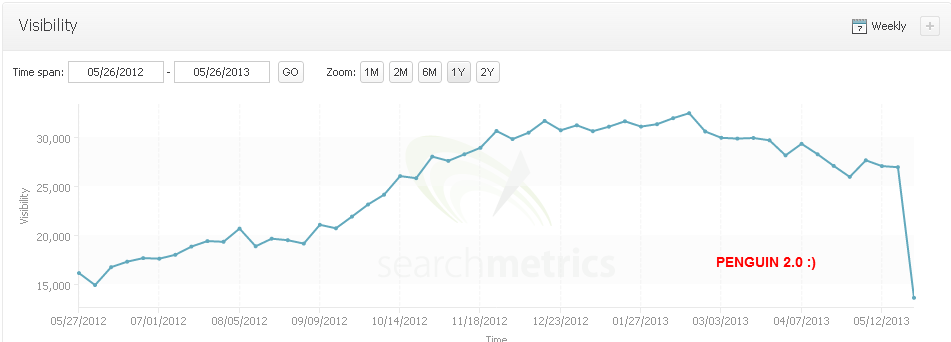It has been a week since the first signs of a major update were spreading across the world wide web. Google officially stated that they rolled out the next generation Penguin webspam algorithm during the afternoon of May 22nd. Since then lots of weblogs have written about the influence of this updated version of the linkspam filter SEOs know as Penguin. As mentioned by Matt Cutts, the influence and intensity of changes will differ per language, or in other words, languages with more spam will see more impact.
During the first days after the announcement, many people stated that the influence was not as big as they had expected. One thing you need to keep in mind is that Google took part in the process of hyping the next version of the link spam detecting algorithm. In one of the reactions, Matt stated clearly that the most spammed SERPs we know, for keywords related to payday loans, gambling and porn would also get cleaned. If you look to the top 10 for [payday loans] in the UK, it looks like nothing has changed. Hopefully he is right and they will sort those cases out too, so we get cleaner SERPs and honest competition possible in those specific niches.
Besides that, I have noticed some other world wide changes taking place in Google during the past weeks. Google started to present more relevant results for brand name queries. A lot of movements took place in that category of keywords. A lot of websites got decent rankings for brand related keywords and were moved back a lot of positions which is in some cases a big part of their overall visibility. Another interesting thing was, that Google only returned 30 results for site: commando searches. They stated that it was a bug, but I think they were adjusting the knobs for the domain diversity / clustering / crowding settings. I have seen a lot of websites getting better rankings because the number of unique domains per 100 results returned, went down.

What is the data telling us?
I personally am a real datageek and after 6 days Searchmetrics has released a lot of ranking and visibility data which gives everyone a little bit more sense of which sites lost their rankings. Stating conclusions after just 24 hours after the official release is not a reliable cause. I actually have seen websites recovering during the last six days, so on the end those drops in rankings had nothing to do with Penguin 2.0. For now I have analysed six countries, based on the top 100 biggest “Losers” (in terms of visibility in the SERPs) websites. You can view the lists on the Searchmetrics website:
– Great Britain
– Germany
– France
– Italy
– Spain
– The Netherlands
I have carefully analysed link profiles of the websites that were hit hardest. The main denominator seems to be thin profiles, lot’s of low quality stuff which in most cases have developed over time. Link velocity and anchor texts are not part of this updated algorithm, as it looks based on the current state of the SERPs. Another general trend is the losses gaming, gambling and porn websites have suffered. Within every country it has been the case since link building got you top positions, that within those three niches, websites build enormous link profiles without thinking about quality requirements. Those tactics delivered results for years after each other as Google focused on other niches first. Now finally they took the right measures to filter those websites out of their result pages.
I’ve seen people talking about big brands that got hit. The ones I saw going down, had other clear reasons for that. People tend to blame Panda or Penguin for their disappointing results, or even negative SEO, but on the end your websites have to function in the right way before you even can start thinking of getting top 3 positions in Google. Always look to onpage factors after blaming external influences.
On the other hand: what I don’t see happening is Google filtering out websites with unrealistic link velocities, one of the general tactics used for high potential keywords like [payday loans]. Another easy to calculate parameter is the number of specific anchor texts compared to complete link profile or that of other websites ranking in the top 10. Two weeks ago I wrote an article on about detecting unnatural linking profiles and Google still finds it difficult to implement this in their ranking and filtering algorithms.
Conclusion: Google still needs to make some steps
Overall, everyone expected more from this quality update by Google. Everyone can easily pinpoint, in every language and in every niche, some websites that are ranking which have debatable link profiles. I’m curious how the situation is after the cooling down and balancing period. Matt Cutts already stated that there will be some visible effects during the upcoming period:
@moxby_summitweb we wanted the first version of Penguin 2.0 to land gently, but we’ll definitely turn up the dial over time.
— Matt Cutts (@mattcutts) 28 mei 2013
What is your opinion on these developments in Google? What do you think is the next step Google will take in creating more usefull result pages?
Thanks for the analysis. It will be interesting to see how this update has an impact on the little guys like me. There are all sorts of websites out there in my field, some of which use nefarious means to rank themselves. I’m thinking that these sites will be too small for Google to bother with.